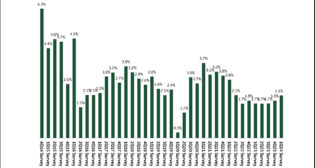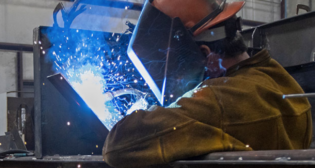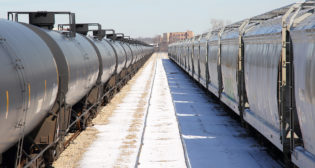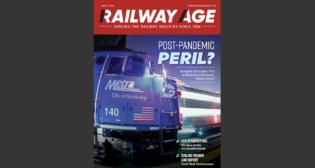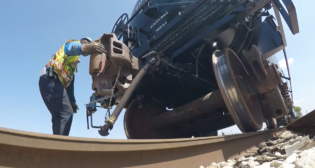
Rising railcar demand prompts aggressive pricing: Matt Elkott
Written by William C. Vantuono, Editor-in-ChiefDemand for new freight cars is on the rise, and builders appear to be aggressively using pricing tools to take advantage of the recovery and retain or increase market share, according to market research conducted by Cowen and Company analyst Matt Elkott.
Pricing should begin to rebound, provided order activity “accelerates and proves sustainable,” Elkott notes, while predicting that the railcar industry’s backlog could bottom out in 2018’s second quarter. However, Greenbrier’s agreement with Tokyo-based Mitsubishi UFJ Lease & Finance Company Ltd. (MUL) to expand their existing commercial relationship in North America “could make first-quarter 2017 a premature, temporary trough.”
(Greenbrier received orders for 11,000 railcars in its fiscal year 2017 third quarter. Excluding orders for 6,000 railcars from the MUL agreement, orders from the company’s traditional North American and European markets were 5,000 units, Greenbrier’s highest level in the past two years and a marked improvement from 700 units in fiscal second-quarter 2017 and 2,400 units in fiscal first-quarter 2017.)
Elkott believes that some key builders “may have become more aggressive in their pricing strategies in recent months. This may appear paradoxical at first given, it is happening at a time when demand is showing signs of life. However, as orders begin to tick up, manufacturers may be compelled to boost their participation in this important early phase of the recovery in order to defend and grow their market shares. This can be a much needed positioning step ahead of a potentially broader recovery, especially as some large builders may have been reluctant to reactivate manufacturing lines for small, sporadic orders during long stretches of the downturn.”
Investors may justifiably be concerned about these signs of aggressive pricing. However, Elkott is not overly concerned as he does not believe the trend will last too long as order activity continues to improve and proves sustainable, “something we believe will occur.” His analysis indicates that second-quarter 2017 orders could exceed 8,000 units, excluding Greenbrier’s 6,000-unit order from MUL. The first quarter’s 4,800 units represented a 1% sequential decline, following 12% and 27% sequential declines in fourth-quarter and third-quarter 2016, respectively. Including Greenbrier’s MUL orders in Cowen’s industry backlog forecast suggests modest backlog growth in second-quarter 2017. “However, we view the first quarter only as a premature, temporary bottom, and maintain that the backlog will resume its declines in third-quarter 2017 until second-quarter 2018,” Elkott notes.
Elkott estimates small-cube covered hopper production could exceed 7,000 units in 2017, a huge increase from the 300 units delivered in the first quarter. As well, he believes that a large portion of the 16,000 of these car types that were backlogged at the end of first-quarter 2017 “could get pulled forward from delivery in 2018 and 2019 to this year. Additionally, a good portion of the new orders coming in are likely for 2017 delivery.”
Other railcar types experiencing “solid” levels of inquiries are plastic-pellet covered hopper, open-top aggregate hoppers and intermodal platforms, based on the railroads looking to increase highway conversions after two years of tough competition from a trucking market “with anemic rates. Indeed, if the current rail volume growth proves sustainable, it could combine with a likely tightening in truckload capacity to drive both trucking and rail rates,” Elkott observes. “With many trucking fleets having frozen their capacity growth over the past couple of years, and with ELD (Electronic Logging Device) implementation set to commence in 2018, conversion from the highway could start picking back up as shippers look to secure intermodal capacity for the long term. We estimate ELDs could reduce overall truckload capacity by 3-5% when fully in place.”
Cowen and Company looks favorably upon Greenbrier, for several reasons. “Concerns that pricing, unfavorable mix shifts and reduced operational leverage would weigh on margins were brought to the forefront when Greenbrier raised its fiscal fourth-quarter 2017 delivery guidance while providing implied earnings guidance well below Street expectations,” Elkott notes. However, he believes Greenbrier “may be a bit conservative in its commentary” and has calculated a 620 bps (basis point) manufacturing gross margin decline for its fiscal fourth-quarter 2017, an amount “less drastic than what the guidance seems to imply.”
As well, the industry’s inherent order and delivery “lumpiness,” as Elkott describes it, “can affect margins at times. We do not know the exact profile of fourth-quarter 2017 deliveries, but it is not necessarily representative of the profile of deliveries in future quarters. As such, we do not expect the fiscal fourth-quarter 2017 margin to be the new reality. That said, we are modeling for fiscal year 2018 manufacturing gross margin to be 130 bps below fiscal-year 2017.”
In addition to Greenbrier, Cowen is favoring Trinity and ARI.
“Greenbrier was able to stave off significant margin compression longer than some of its peers in this down cycle,” Elkott says. “For Trinity and ARI, much of the compression is already occurring, with the remainder likely reflected in current earnings expectations to a large degree. As such, we are not too concerned about upcoming earnings by the two companies. The fact that Greenbrier received organic orders for 5,000 railcars without the help of frac sand hoppers bodes well for Trinity and ARI. Not only does this suggest that the demand recovery may be more broad-based across car types than many may have thought, but it could also mean that Trinity and ARI may have received solid frac sand car orders as they are two of the go-to builders for that equipment.”
Elkott has reiterated Cowen’s long-term favorable opinion of Greenbrier, saying that the pullback in its shares was attributable to “profit-taking following a pre-earnings rally and concerns about margin compression that are valid but somewhat overblown. Additionally, we do not believe Greenbrier’s results and outlook commentary are a big cause for concern for results by peers.”
